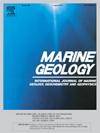Carbonate sediment dynamics in oceanic atoll lagoons of Lakshadweep Archipelago
IF 2.2
3区 地球科学
Q2 GEOSCIENCES, MULTIDISCIPLINARY
引用次数: 0
Abstract
Atoll lagoons grow by constant sediment supply and are increasingly being affected by climate change. The impacts are non-uniform; thus, understanding the mechanisms governing the sediment dynamics is crucial to assessing atoll island stability. Satellite geomorphological and sedimentological studies have been conducted on Agatti and Kavaratti atolls in the Lakshadweep Archipelago (Northern Indian Ocean) to discern factors governing sediment dynamics. These lagoons, with maximum depths of 4 m, are grainstone-dominated (79 % - Agatti & 96 % - Kavaratti). Sand-sized fractions (2–0.125 mm) constitute approx. 87 % and 90 % of the Agatti and Kavaratti lagoon, respectively. The major sediment producers include corals (34–57 % - Agatti; 37–58 % Kavaratti) and molluscs (31–34 % - Agatti; 32–39 % - Kavaratti) followed by forams (8–20 % - Agatti; 2–13 % - Kavaratti), algae (2–7 % - Agatti; 2–10 % - Kavaratti) and Halimeda (1–6 % - Agatti; 1–10 % - Kavaratti); within each sample fraction. Coral clasts and molluscs are prevalent near the north, and algae (including Halimeda) is abundant in the south in Agatti. In Kavaratti, molluscs and algae, and Halimeda are prevalent in the north (near the dredging channel) compared to coral clasts. For both atolls, forams are confined to the south and in the lagoon's interior. Generally, for both atolls, coral clasts and algae (including Halimeda) decrease from the reef flat to the island, while molluscs show opposite trends. Reef flats, patch reefs and seagrass patches serve as significant production zones. Anthropogenic factors (dredging) have altered ocean parameters, evidenced by an increase in algae and molluscs and a decrease in coral clasts. The wave-induced currents dictate sediment redistribution, with lighter components such as molluscs and coral clasts transported across the lagoon, while sheltered zones retain particular components such as forams. The small size of the atolls, shallow bathymetry and sand-sized sediments imply potential bucket fill. As climate change progresses, intensified wave-induced currents (linked to stronger monsoons) will result in the retention of coarse-grained sand, with these components dictating future sediment supply. Coupled with rising coral mortality, molluscs would become dominant, affecting sediment production; leading to land loss. The study underscores the importance of local factors such as geomorphic zones and hydrodynamics in discerning island stability in terms of climate change.
Lakshadweep群岛海洋环礁泻湖碳酸盐沉积动力学
环礁泻湖依靠不断的沉积物供应而增长,并日益受到气候变化的影响。冲击是不均匀的;因此,了解控制沉积物动力学的机制对评估环礁岛的稳定性至关重要。对拉克沙德韦普群岛(北印度洋)的Agatti和Kavaratti环礁进行了卫星地形学和沉积学研究,以查明控制沉积动力学的因素。这些泻湖的最大深度为4米,以谷粒岩为主(79% - Agatti;96%——Kavaratti)。砂粒级分数(2-0.125 mm)约占。阿加蒂泻湖和卡瓦拉蒂泻湖的比例分别为87%和90%。主要的沉积物产生者包括珊瑚(34 - 57% - Agatti;37 - 58% Kavaratti)和软体动物(31 - 34% Agatti;32 - 39%——卡瓦拉蒂),其次是有孔虫(8 - 20%——阿加蒂;2 - 13%——Kavaratti),藻类(2 - 7%——Agatti;2 - 10% -卡瓦拉蒂)和哈利梅达(1 - 6% -阿加蒂;1 - 10% (Kavaratti);在每个样本分数内。珊瑚碎屑和软体动物在北部附近普遍存在,藻类(包括halmeda)在Agatti南部丰富。在卡瓦拉蒂,与珊瑚碎屑相比,软体动物、藻类和halmeda在北部(靠近疏浚通道)普遍存在。在这两个环礁上,有孔虫都局限于南部和泻湖的内部。一般来说,对于两个环礁,珊瑚碎屑和藻类(包括halmeda)从礁滩向岛屿减少,而软体动物则呈现相反的趋势。礁滩、斑礁和海草斑是重要的生产区。人为因素(疏浚)改变了海洋参数,藻类和软体动物的增加和珊瑚碎屑的减少就是证据。波浪引起的水流决定了沉积物的再分配,软体动物和珊瑚碎屑等较轻的成分被带过泻湖,而庇护区保留了有孔虫等特殊成分。环礁的小尺寸,浅水深和沙粒大小的沉积物意味着潜在的桶填充。随着气候变化的进展,波浪引起的洋流(与更强的季风有关)的增强将导致粗粒沙的保留,这些成分决定了未来的沉积物供应。再加上珊瑚死亡率的上升,软体动物将成为主导,影响沉积物的产生;导致土地流失。这项研究强调了当地因素的重要性,如地貌带和水动力学在气候变化方面辨别岛屿的稳定性。
本文章由计算机程序翻译,如有差异,请以英文原文为准。
求助全文
约1分钟内获得全文
求助全文
来源期刊

Marine Geology
地学-地球科学综合
CiteScore
6.10
自引率
6.90%
发文量
175
审稿时长
21.9 weeks
期刊介绍:
Marine Geology is the premier international journal on marine geological processes in the broadest sense. We seek papers that are comprehensive, interdisciplinary and synthetic that will be lasting contributions to the field. Although most papers are based on regional studies, they must demonstrate new findings of international significance. We accept papers on subjects as diverse as seafloor hydrothermal systems, beach dynamics, early diagenesis, microbiological studies in sediments, palaeoclimate studies and geophysical studies of the seabed. We encourage papers that address emerging new fields, for example the influence of anthropogenic processes on coastal/marine geology and coastal/marine geoarchaeology. We insist that the papers are concerned with the marine realm and that they deal with geology: with rocks, sediments, and physical and chemical processes affecting them. Papers should address scientific hypotheses: highly descriptive data compilations or papers that deal only with marine management and risk assessment should be submitted to other journals. Papers on laboratory or modelling studies must demonstrate direct relevance to marine processes or deposits. The primary criteria for acceptance of papers is that the science is of high quality, novel, significant, and of broad international interest.
 求助内容:
求助内容: 应助结果提醒方式:
应助结果提醒方式:


